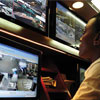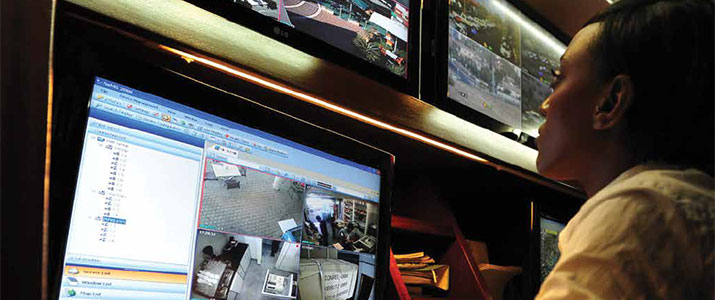
Reimagining Strategies
Mobile technology is changing the security landscape
- By Steve Surfaro
- Mar 01, 2014
 Security is no longer chained to a desktop, and breaking these chains
has changed the face of remote monitoring. It used to be that remote
monitoring meant keeping an eye on things from a central
station, like a corporate security command center or even a thirdparty
monitoring service. However, the introduction of mobile devices
- laptops, smartphones and tablets - has changed all that. And, authorization
to view video can be easily extended to include law enforcement, first responders
and other agencies in need of situational awareness.
Security is no longer chained to a desktop, and breaking these chains
has changed the face of remote monitoring. It used to be that remote
monitoring meant keeping an eye on things from a central
station, like a corporate security command center or even a thirdparty
monitoring service. However, the introduction of mobile devices
- laptops, smartphones and tablets - has changed all that. And, authorization
to view video can be easily extended to include law enforcement, first responders
and other agencies in need of situational awareness.
Today, mobility has extended to camera technology, as well. With Wi-Fi and
VPNs, mobile trailers and SD cards for in-camera storage, video technology is no
longer anchored to coax and fiber-optic cabling. This freedom represents a great
financial opportunity for integrators and end-users alike.
For the integrator, remote monitoring services and hosting a customer’s video
in the cloud represents a change in business model from front-loading a customer’s
technology investment to establishing a recurring monthly revenue stream for system
usage and services. Customers enjoy the advantage of using the latest IP video
technology and accessing their video anytime, anywhere without a hefty capital
expenditure or having to worry about system maintenance.
The potential financial barrier to enjoying sophisticated video surveillance and
remote monitoring has virtually melted away, and the opportunity to benefit from
continuously updated cloud services has appeared.
Putting Temporary Venues on the Watch List
Whether it’s an annual festival or this week’s crime hotspot, remote surveillance
technology is proving to be a real force multiplier for event managers and law enforcement
agencies.
Several companies offer video surveillance systems mounted on mobile platforms
that can rest on a trailer and be towed from site to site as needed. The
platform’s chassis houses the video server and video management software while
HDTV-quality, network cameras mounted on telescoping masts give security staff
a panoramic, bird’s-eye view of the surrounding area.
A high-powered, secure wireless access point enables the video to be streamed
to authorized users on their mobile devices whether they’re sitting in a command
trailer down the block, patrolling the venue on foot or circling the locale by car.
Video also can be streamed to police headquarters, patrol cruisers or any agency
operations center with a need to keep an eye on the site. Some mobile trailers even contain public address systems with sirens that allow staff, monitoring the cameras remotely, to verbally
address individuals observed in the vicinity of the surveillance unit.
A suburban Chicago police force, for example,
uses a similar setup to curtail criminal activity in
certain neighborhoods—anything from drug deals
to burglary to vandalism. Once a rash of incidents is
contained at one location, the mobile surveillance system
is moved to the next problem area that arises. At
home or on the road, the chief of police can monitor
the situation on his tablet, direct resources and decide
whether the nature of the incident requires his presence
on site.
This set up has also proven popular for event organizers
working in cooperation with local, state and
federal agencies to monitor high-crime areas, sports
venues and rallies. Network cameras, mounted on mobile
tripods, equipped with wireless technology, stream
video to a surveillance trailer as well as to agencies
across the country responsible for pursuing crime.
Increasing Vigilance for
Visiting Dignitaries
Sports venues often establish a dual-monitoring environment—
one for security staff to keep an eye on
normal, game-day activity and another for special
surveillance teams to keep an eye on visiting dignitaries
like heads of state, celebrities and other high-profile
individuals in attendance. The former is typically
used for crowd control and forensic purposes, and
usually includes a security command center with a
video wall of cameras covering the premise. The command
center can push video to the mobile devices of
the security team patrolling the venue. The secondary
monitoring environment gives law enforcement and
government agencies, such as the Secret Service, access
to the video so that agents can focus on specific
individuals they are responsible for protecting.
Multi-purpose venues are a good model for undertanding how to match changing user requirements with infrastructure and security
endpoint devices like network cameras, physical access control panels and
intrusion detection sensors. To minimize risk, before, on and after game or event
day, surveillance is heightened and cameras, portals and systems are monitored
to provide an appropriate security posture. When high-profile visitors attend the
venue, the same infrastructure must support the additional demands of multiple
agencies that require both live and forensic video content sharing.
Coordinating Responders to Emergency Situations
Modeling remote monitoring requirements still involves the same basic scenario
of matching infrastructure to user needs, but the system designer also needs to
factor in the demands of differently-tasked users with complex needs and simultaneous
activities. For instance, emergency medical response teams can transmit
video, audio and patient health data to hospital staff for initial diagnosis and triage.
Today’s HDTV video surveillance systems can send streaming video or highresolution
still images when less bandwidth is available, which can result in a more
accurate remote diagnosis.
An engine company streaking to the scene of a fire might set up video surveillance
to improve situational awareness and help the company decide whether additional
rescue and medical equipment needs to be dispatched to the scene. Once on
site, firefighters, equipped with wearable video surveillance devices, can help remote
specialists, reviewing site floor plans, by safely guiding them in real-time through
hallways and stairwells to rescue victims or avoid HAZMAT storage.
In an active shooter or other violent event, law enforcement often relies on active,
remote, video monitoring to provide dispatched officers with critical situational
awareness of the scene they’re about to enter. This real-time surveillance helps officers
stay ahead of the threat when abnormal behavior is detected and provides verification
of alarm signals. Video verification of alarm signals not only reduces the waste
of resources on false alarms, but it also helps law enforcement devise an appropriate
response strategy, especially when dealing with armed and violent criminals.
When situations arise calling for coordination with local law enforcement, businesses,
schools and other organizations, often providing remote access to surveillance
video is a critical component of the forensic investigation. Remote monitoring
might incorporate advanced features, permitting an instant review of recent
events. Fast access of summarized, video data in a compressed time format helps
to pinpoint persons and vehicles (including license plates) of interest, followed by
traditional, full-video, content review around those times.
Configuring Effective Remote Monitoring Solutions
Whether using wireless or hard-wired connectivity, quality of service is key. While
no one can model every demanding situation, because video streaming and accessing
scenarios tend to be dynamic and fluid, it’s important to have a network
that can effectively manage both the video sources and the consuming devices. For
instance, video could be streamed to mobile device users at a lower resolution and
frame rate than video streamed to a command center.
Allocating spectrum. Whether video surveillance is sharing the pipeline of a
public or private network, allocating a dedicated spectrum—bandwidth and frequency—
for video traffic helps avoid diminished quality of service. This issue is
often raised in school district surveillance where administrators are concerned
about the impact of video on network availability and performance needed for
academic technology that shares the pipeline.
Some address this dilemma by establishing a separate VLAN to segregate a
portion of network bandwidth exclusively for video traffic. Others address this
dilemma by adopting a cloud approach to surveillance where the environment is
elastic enough to accommodate the occasional peak demand by mobile devices in
a crisis. It’s best to work with an end-user’s IT department to determine the most cost-effective solution for any given installation.
Tying in with other security systems.
Remote monitoring becomes more
meaningful when you link video with
other data. Whether the alarm is security
related or an environmental issue,
when it goes off, video gives you
the situational awareness you need to
verify what’s happening. Who entered
the secure records room after hours?
Is there really a fire in the hallway? Is
the server array offline? Does the temperature
gauge indicate the room is too
hot or too cold? Real-time situational
awareness helps end-users quickly marshal
the resources needed to deal with
a problem while avoiding the costs associated
with false alarms.
Protecting video from unauthorized
eyes. Like any highly sensitive data,
surveillance video can be a tempting
target. In a remote monitoring environment,
it’s especially important to
authenticate users and control access to
live feeds and recorded content. There
are a number of steps you can take to
ensure cyber security and video integrity,
from using cameras equipped with
Port Authentication Protocol (802.1x)
and encrypting video streams to authenticating
users and their devices
with digital certificates of authority.
- The 802.1x protocol ensures that a
user or device cannot make a full
network connection until they are
properly authenticated and have
permission to access a particular
camera and/or video recording.
- VPN tunneling technology creates a
private tunnel for streaming data between
the camera and the user, and
supplies private keys for encryption
to avoid eavesdropping, hijacking
and modification of video data. Protect both ends of the VPN connection
with firewalls and intrusion prevention
systems to further secure the
transmission. This is especially important
for law enforcement, protecting
sensitive forensic evidence from
showing up on YouTube, for example.
- Digital certificates of authority help
control the gateway between the
remote users and the camera or recorded
video by independently verifying
the identity of the source device
and the consuming device. This
certificate allows a security director
to easily establish or revoke privileges
to produce, store, playback
and display video content. But, with
the proliferation of corporate and
personal mobile devices accessing
the network, certificates need to
go hand-in-hand with a company’s
Bring Your Own Device (BYOD)
policy, such as requiring automatic
download of anti-virus updates at
logon—to prevent users from accidentally
or deliberately introducing
malware onto the network.
Collaborating with IT professionals.
Especially if video surveillance is sharing
the corporate network, it’s important
to partner with the IT department
to ensure that any remote monitoring
schema doesn’t create vulnerabilities
for the network.
Provisioning on the fly. Especially in
temporary venues, where the installation
timeframe tends to be short, there
are a number of ways to speed up deployment.
One is to preprogram the
cameras before installation to automatically
stream to the server when they’re
powered on. Another way is to use a
one-click feature once the camera is installed,
which causes it to automatically
begin seeking the central station.
Remote Possibilities
are Endless
Technology continues to push the mobility
envelope, opening up lucrative
opportunities for integrators and resellers
to reimagine remote monitoring
solutions for their customers. Whether
the solution incorporates mobile video
camera platforms, mobile command
centers, security patrols equipped with
smart devices, third-party monitoring
services or hosting video in the cloud,
the permutations are endless.
For integrators, remote monitoring
represents an opportunity to build a
recurring monthly revenue stream. For
end-users, remote monitoring represents
an opportunity to acquire critical situational
awareness anytime, anywhere.
Incorporating the latest advances in encryption
and authentication into a solution
instills confidence in end-users that
the surveillance system can be responsive
to their remote monitoring needs
without compromising the security of
their sensitive video data.
This article originally appeared in the March 2014 issue of Security Today.